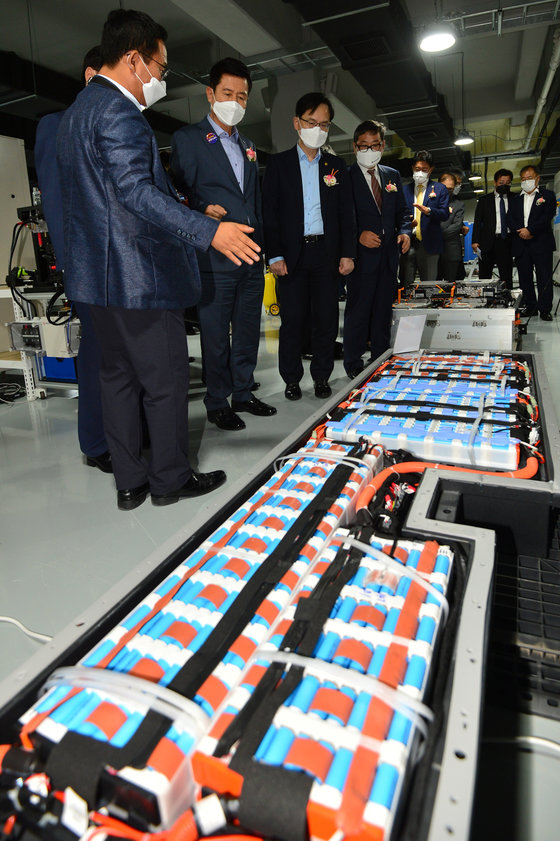 Pohang Mayor Lee Gang-deok, Vice Minister of SMEs and Startups Kang Seong-cheon, Pohang City Mayor Jeong Jeong-jong, and other guests are looking around the interior after the completion ceremony of the rechargeable battery management center held at the National Blue Valley Industrial Complex in Donghae-myeon, Nam-gu, Pohang-si, Gyeongsangbuk-do, on the 13th. News1 © News1
Pohang Mayor Lee Gang-deok, Vice Minister of SMEs and Startups Kang Seong-cheon, Pohang City Mayor Jeong Jeong-jong, and other guests are looking around the interior after the completion ceremony of the rechargeable battery management center held at the National Blue Valley Industrial Complex in Donghae-myeon, Nam-gu, Pohang-si, Gyeongsangbuk-do, on the 13th. News1 © News1As Korean battery companies dominated new investments in the US last year, the proportion of local battery production facilities is expected to increase to 70% by 2025.
In Europe, where it already maintains an overwhelming market share, it plans to double production by 2025.
On the 12th, the Ministry of Trade, Industry and Energy announced the investment and production performance and future prospects of Korean battery companies in the global market last year.
Last year, Korean companies participated in most of the new battery production facilities in the United States, demonstrating an overwhelming advantage in new facility investment.
According to the U.S. Department of Energy (DOE), 11 of the 13 large-scale battery production facilities scheduled to be built in the U.S. by 2025 were related to the three Korean companies (LG Energy Solution, SK On, and Samsung SDI).
Currently, battery facilities operated by domestic companies in the United States account for 10.3% of all production facilities in the United States, but the proportion is expected to increase to 70% by 2025 when the previously announced plan is completed.
In the EU region, the three domestic battery companies already occupy most of the market thanks to the preemptive investment of Korean companies since 2017.
Among the battery production facilities in the EU, Korean companies accounted for 64.2% of the total, and last year, the three domestic battery companies’ sales share in the EU market was 71.4%.
To remain competitive in the EU, companies plan to double their current production capacity by 2025.
However, in China, which is the largest, Chinese companies occupy more than 80% of the market, so Korean companies’ performance is relatively poor compared to the EU and the US.
Last year, the growth of battery companies and the growth of domestic materials, parts and equipment companies
It was a year of growth as a global company.
The sales of the four major materials companies are expected to increase by more than 20% compared to the previous year. In addition, six domestic material companies have achieved the achievement of entering the global TOP10.
Efforts were also made to ensure a stable supply of key raw materials for secondary batteries.
Lithium hydroxide, which is mainly imported from China, is currently being pursued by three battery companies to diversify its importing countries into Australia, Chile, and Argentina. With the goal of localization rate of 37% by 2025, POSCO and Ecopro are investing in domestic facilities.
Recycling of batteries is also being promoted. It plans to secure production capacity of 17,000 tons by 2025 and 27,000 tons by 2030 through the establishment of a demonstration center and development of process automation technology.
For nickel and cobalt, the three battery companies and POSCO have started to secure equity investment in mining companies and long-term purchase contracts.
(Sejong = News 1)
.